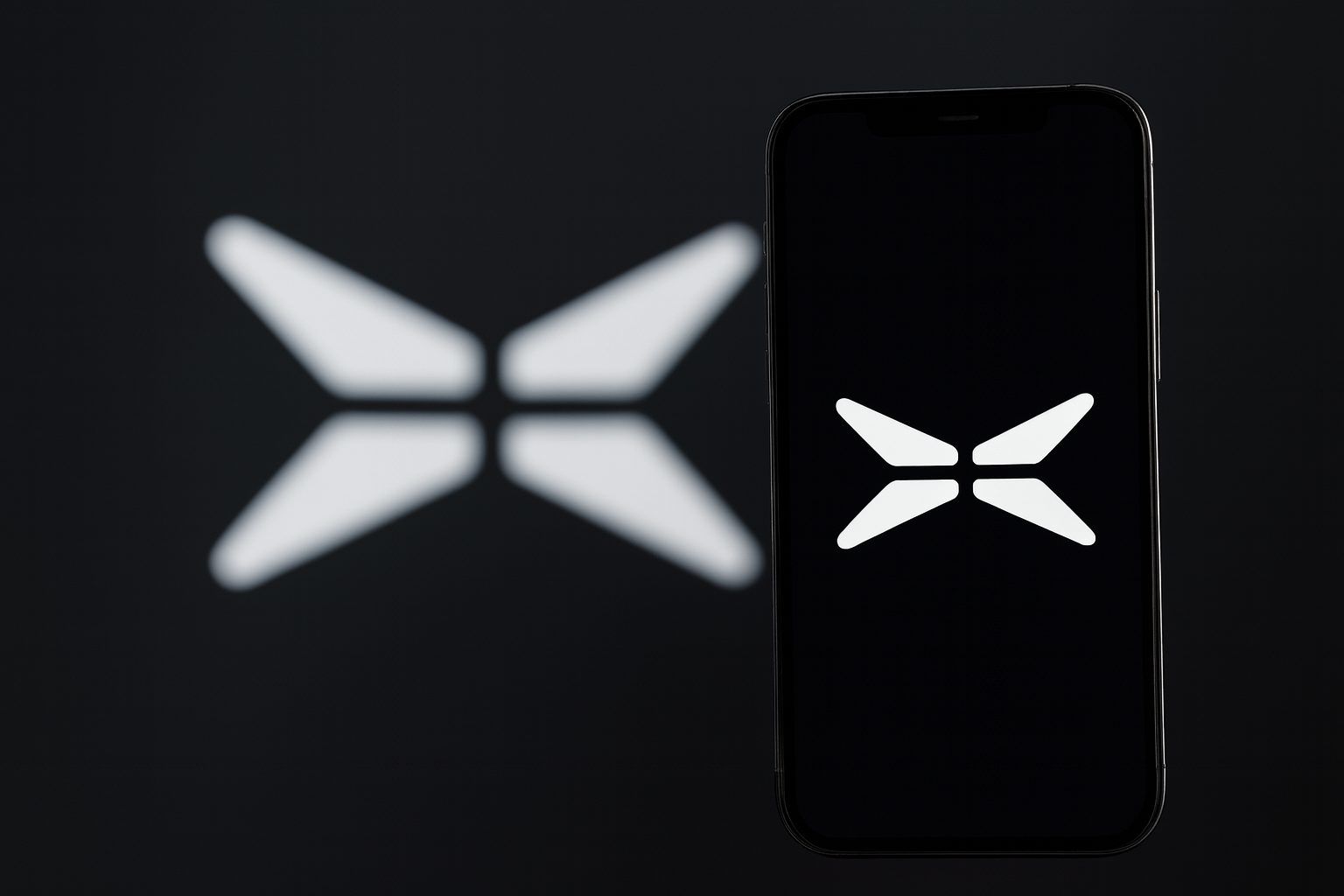Ticker: XPeng Inc. American depositary shares, each representing two Class A ordinary shares (NYSE: XPEV)
Quick take for today
As of early Thursday, 27 November 2025, XPeng Inc.’s U.S.-listed ADRs are trading around $21 per share, after closing on Wednesday at $21.14, down just over 2% on the day. That leaves the Chinese electric‑vehicle maker well below its recent November peak but still far above its 12‑month low of about $11.14. XPeng’s market value sits around $20–21 billion. [1]
The stock is digesting a huge year for the company: record deliveries, a major AI and humanoid‑robot push, deeper technology ties with Volkswagen, and rapid international expansion — capped this week by an official entry into Colombia.
Below is a detailed look at where XPEV stands today (27 November 2025) and the latest news that matters for shareholders and traders.
XPeng stock price on 27 November 2025
- Last U.S. close: $21.14 per ADR on 26 November 2025
- Move on the day: roughly –2.2% vs. the prior close, with an intraday range around the low‑$21s. [2]
- 12‑month range: approximately $11.14–$28.23 per share. [3]
- Market cap: about $20.6 billion. [4]
- Structure: each XPEV ADR represents two Class A ordinary shares of XPeng Inc. [5]
Short‑term technically, XPeng has pulled back sharply: quantitative analysis from StockInvest notes that XPEV has fallen roughly 22% over the past 10 trading days and is trading in the lower part of a wide, falling trend channel — high volatility, but also potential for sharp swings in either direction. [6]
Fresh market color today: options flows turn “moderately bullish”
While XPeng hasn’t released a new company press release on 27 November itself, there is fresh market activity around the stock today.
Options‑flow tracker TheFly (via TipRanks) describes “moderately bullish” activity in XPeng:
- Shares were recently quoted about $0.66 higher, up 3.18% near $21.59 in today’s trading snapshot.
- Options volume was around 34,000 contracts, with calls heavily outnumbering puts (put/call ratio about 0.19, below the usual ~0.27 level).
- 30‑day implied volatility eased to roughly 56, in the lower quartile of the past year, implying an expected daily move of about $0.77. [7]
This intraday options activity follows a series of analyst upgrades and price‑target hikes over the last couple of weeks:
- Daiwa upgraded XPeng to Buy from Hold and set a $29 price target. [8]
- Bank of America raised its target to $28 while keeping a Buy rating. [9]
- Goldman Sachs recently lifted its target to $25 amid what it called growing optimism around XPeng’s execution. [10]
- Earlier in November, Morgan Stanley boosted its Hong Kong target to the equivalent of roughly $34 after XPeng’s AI Day and robot announcements. TechStock²
Across Wall Street, TipRanks aggregates a “Moderate Buy” consensus for XPEV with an average 12‑month target of $29.43, implying about 45% upside from current levels. Blogger sentiment is overwhelmingly bullish, while crowd sentiment over the past 30 days also tilts positive. [11]
Colombia launch: XPeng’s 55th global market
One of the newest company‑specific headlines heading into today is XPeng’s expansion into Colombia, announced this week and highlighted on 26–27 November across regional and investor news outlets. [12]
Key points:
- Colombia becomes XPeng’s 55th global market, putting the company within striking distance of its stated goal of operating in more than 60 countries by the end of 2025. [13]
- XPeng is launching its G6 and G9 electric SUVs in the country.
- The vehicles are significantly more expensive than Tesla’s Model Y in Colombia, positioning XPeng more as a premium, tech‑heavy choice than a price leader. [14]
- Distribution is being handled via local partner Inchcape, a classic “asset‑light” approach where XPeng leverages existing dealer infrastructure instead of building factories or large owned retail footprints. [15]
This move follows a busy October in which XPeng entered seven new international markets — Lithuania, Latvia, Estonia, Cambodia, Morocco, Tunisia and Qatar — bolstering its presence across Europe, Asia, and Africa. [16]
Taken together, the October and November expansion steps underscore XPeng’s strategy of rapid overseas rollout with local partners, particularly important at a time when:
- The EU has imposed countervailing tariffs of roughly 17–35% on Chinese‑made EVs on top of its standard 10% import duty, and is now re‑evaluating the effectiveness of those measures. [17]
- The U.S. maintains a 100% tariff on Chinese EVs under Section 301, effectively closing the American market to direct imports. [18]
XPeng’s choice of markets like Colombia – where Chinese EVs face fewer trade barriers – reflects a deliberate pivot toward regions with friendlier regulatory and tariff regimes.
Q3 2025 earnings: explosive growth, shrinking losses
XPeng’s last major earnings update (released 17 November 2025) remains central to how the market is valuing XPEV today. [19]
Headline numbers for Q3 2025
According to XPeng’s unaudited Q3 2025 results:
- Total revenue:
- RMB 20.38 billion (~US$2.86B), up 101.8% year‑on‑year (YoY) and 11.5% quarter‑on‑quarter (QoQ).
- Vehicle sales revenue:
- RMB 18.05 billion, up 105.3% YoY and 6.9% QoQ.
- Gross profit:
- RMB 4.10 billion, up 166% YoY, with gross margin improving to 20.1% (from 15.3% a year earlier).
- Vehicle margin:
- 13.1%, up from 8.6% a year ago, though slightly down from 14.3% in Q2.
- Net loss attributable to ordinary shareholders:
- RMB 0.38 billion (~US$50 million), a sharp improvement from RMB 1.81 billion a year earlier and RMB 0.48 billion in Q2.
- Non‑GAAP net loss:
- RMB 0.15 billion, down more than 90% year‑on‑year.
On a per‑share basis, XPeng reported:
- Net loss per ADS: RMB 0.40 (US$0.06)
- Non‑GAAP net loss per ADS: RMB 0.16 (US$0.02) [20]
TipRanks notes that this translated into EPS of about –$0.056 vs. a –$0.051 consensus, prompting an immediate ~10% drop in the share price after the release despite the strong growth metrics. [21]
Deliveries: above 40,000 units for two straight months
XPeng’s growth story in 2025 is best seen in its delivery numbers:
- October 2025:
- 42,013 vehicles, up 76% YoY and 1% MoM – XPeng’s second consecutive month above 40,000 units.
- Year‑to‑date deliveries through October reached 355,209 vehicles, up 190% vs. the same period of 2024.
- XPeng also highlighted strong user engagement with its XNGP advanced driver‑assistance system, which reached 86% penetration among urban monthly active users. [22]
- August 2025:
- 37,709 vehicles, up 169% YoY and 3% MoM, a new monthly record at the time.
- Deliveries for the first eight months of 2025 totaled 271,615 units, up 252% versus 2024.
- The all‑new P7 sports sedan launched on 27 August with nationwide deliveries starting the next day, and XPeng reported 85% urban MAU penetration for XNGP. [23]
Earlier in the year, Q1 2025 results showed:
- Revenue of RMB 15.81 billion, up 141.5% YoY.
- 94,008 deliveries, a 330.8% YoY surge.
- Gross margin at 15.6% and vehicle margin at 10.5%, both significantly higher than in 2024. [24]
Put simply, 2025 has been a breakout year operationally: deliveries have more than tripled, margins have expanded, and net losses have narrowed dramatically — though XPeng is still not profitable.
Physical AI, IRON humanoid robot and robotaxis
Another major narrative driving XPEV this year — and still very much alive today — is XPeng’s push into “Physical AI”.
At XPENG AI Day 2025 on 5 November, the company showcased: [25]
- XPENG VLA 2.0, a next‑generation vehicle‑level AI platform.
- A robotaxi solution aimed at commercial deployment in 2026, in partnership with Alibaba’s Amap mapping platform.
- The Next‑Gen IRON humanoid robot, capable of human‑like movement and natural interaction.
- Updates on its AEROHT flying EV concepts and super‑fast 5C charging.
Media coverage highlighted how XPeng’s Hong Kong–listed shares surged as much as 18% following the event, as investors embraced the idea that XPeng could become a broader AI mobility platform, not just an automaker. TechStock²
The company’s messaging is clear:
- Mass‑production of humanoid robots is targeted for 2026. [26]
- Robotaxis and AI‑defined cars should eventually feed data back into XPeng’s foundation models, improving autonomous driving and services.
This is high‑risk, high‑reward territory: it supports the growth and “tech optionality” story that analysts like Morgan Stanley and Goldman Sachs point to, but it also means elevated R&D spend and heavy capital needs for years to come. [27]
Volkswagen partnership: software validation at scale
Beyond its in‑house AI work, XPeng is gaining third‑party validation through its deepening partnership with Volkswagen Group.
In August 2025, the two companies signed an agreement to expand their Electrical/Electronic (E/E) Architecture collaboration: [28]
- XPeng’s jointly developed E/E architecture will be used not only in Volkswagen’s EVs, but also across its internal‑combustion (ICE) and plug‑in hybrid (PHEV) platforms in China.
- The shared architecture is designed to enable faster software iteration, smoother over‑the‑air updates, and shorter development cycles across VW’s Chinese portfolio.
- Analysts see this as a powerful technology and revenue validation for XPeng, as it effectively licenses its software‑centric platform into a much larger installed base.
For XPeng shareholders, the VW deal adds a second leg to the investment case: XPeng is not just selling its own cars, but also exporting its software and electronics stack to a global auto giant.
Competitive and regulatory backdrop: crowded field, tariff headwinds
XPeng is operating in an EV landscape that is changing almost weekly:
- China’s home market is fiercely competitive. BYD, for instance, just reported that its Fang Cheng Bao Ti7 plug‑in hybrid SUV hit 50,000 sales in only 80 days, underscoring how quickly new models can scale in China. [29]
- BYD has even cut its full‑year 2025 sales target due to industry overcapacity and intense price wars — a warning sign for all Chinese EV makers, including XPeng. [30]
- The EU’s tariffs on Chinese EVs, reaching up to around 45% in some cases, are still under political debate, with Brussels and Beijing now exploring alternatives such as minimum pricing. [31]
- The U.S. 100% tariff on Chinese EVs, in place since 2024, remains a structural barrier to XPeng ever exporting cars directly to the American market in the near term. [32]
The net effect: XPeng’s impressive volume growth and tech narrative are happening against a backdrop of policy risk, price pressure, and global trade friction.
Analyst view vs. recent share‑price action
Analyst commentary during November has had a consistent theme: “fundamentals good, price weak.”
- TipRanks’ AI‑generated note “Analysts Bullish Despite Stock Dip” calculates that XPeng’s stock fell roughly 9% over the past week, yet still enjoys an average Street target (in Hong Kong terms) implying 30–40% upside. [33]
- The same report cites strong revenue growth, narrowing losses, and multiple firms (Citic, DBS, Daiwa and others) reiterating Buy ratings, even as the share price lagged. [34]
Taken together with options flow today and the growing pipeline of AI and robotics projects, the current setup looks like this:
Bullish arguments
- Deliveries and revenue more than doubled year‑on‑year in Q3. [35]
- Gross margin has climbed above 20%, with vehicle margins in the low teens. [36]
- Net losses are shrinking rapidly and management still targets a move toward profitability in late 2025/2026. [37]
- International expansion is scaling quickly (55+ markets, including Colombia), helping diversify away from China‑only reliance. [38]
- The VW deal and the Physical AI roadmap (IRON humanoid, robotaxis, flying EVs) provide high‑profile tech partnerships and optionality. [39]
Bearish arguments
- The stock has been extremely volatile, with double‑digit percentage swings around events like AI Day and earnings. TechStock²+2TipRanks+2
- XPeng is still loss‑making, with heavy R&D and SG&A spend needed to fund AI, robotics and global expansion. [40]
- Global trade barriers (EU and U.S. tariffs) put a ceiling on some of the international EV opportunity. [41]
- Competition from both established giants (BYD, Tesla) and other Chinese “new energy vehicle” makers remains intense, especially in mid‑priced SUVs and sedans. [42]
What XPeng investors are watching next
Looking beyond today’s price, here are key catalysts and risks that matter after 27 November 2025:
- Monthly delivery releases
- XPeng typically publishes its delivery numbers soon after month‑end. With October at 42,013 units, investors will watch November data closely to see whether XPeng can sustain or accelerate its >40,000‑unit run‑rate. [43]
- Path toward profitability
- Management has previously pointed to Q4 2025 or 2026 as a window for achieving break‑even on a non‑GAAP basis, driven by scale, mix and software/service revenue. Q4 and FY 2025 guidance and commentary will be critical. [44]
- Execution on Physical AI and robotaxis
- The market will want proof that IRON and robotaxis can move from flashy demos to commercial revenue streams by 2026, without derailing XPeng’s balance sheet. TechStock²+2PR Newswire+2
- VW collaboration milestones
- Investors will track when the shared E/E architecture starts shipping across multiple VW platforms, and whether XPeng discloses any licensing or royalty economics. [45]
- Tariff and policy developments
- Any changes in EU tariffs or new trade friction could quickly change XPeng’s addressable markets, particularly in Europe and emerging markets. [46]
Bottom line on XPEV for 27 November 2025
On 27 November 2025, XPeng stock sits at an interesting crossroads:
- The business metrics – deliveries, revenue growth, margin progress, global footprint – look stronger than ever. [47]
- Analysts and options traders remain generally constructive, seeing notable upside from current prices. [48]
- At the same time, the shares are well off their recent highs, reflecting real concerns about profitability, competition and geopolitics.
For news‑driven traders, today’s focus is on fresh options activity and the Colombia expansion adding yet another pin to XPeng’s global map. For longer‑term investors, the key questions now are whether XPeng can turn its 2025 growth spurt into durable cash generation – and how much value the market should assign to its Physical AI and software platform ambitions.
References
1. www.stocktitan.net, 2. stockinvest.us, 3. www.tipranks.com, 4. www.stocktitan.net, 5. www.nasdaq.com, 6. stockinvest.us, 7. www.tipranks.com, 8. www.tipranks.com, 9. www.tipranks.com, 10. finance.yahoo.com, 11. www.tipranks.com, 12. stocktwits.com, 13. www.stocktitan.net, 14. stocktwits.com, 15. stocktwits.com, 16. www.stocktitan.net, 17. merics.org, 18. www.asil.org, 19. www.prnewswire.com, 20. www.prnewswire.com, 21. www.tipranks.com, 22. www.stocktitan.net, 23. www.stocktitan.net, 24. www.stocktitan.net, 25. www.prnewswire.com, 26. www.stocktitan.net, 27. www.prnewswire.com, 28. www.stocktitan.net, 29. carnewschina.com, 30. cryptorank.io, 31. www.reuters.com, 32. www.asil.org, 33. www.tipranks.com, 34. www.tipranks.com, 35. www.prnewswire.com, 36. www.prnewswire.com, 37. www.stocktitan.net, 38. stocktwits.com, 39. www.stocktitan.net, 40. www.prnewswire.com, 41. www.asil.org, 42. carnewschina.com, 43. www.stocktitan.net, 44. www.stocktitan.net, 45. www.stocktitan.net, 46. www.reuters.com, 47. www.prnewswire.com, 48. www.tipranks.com







